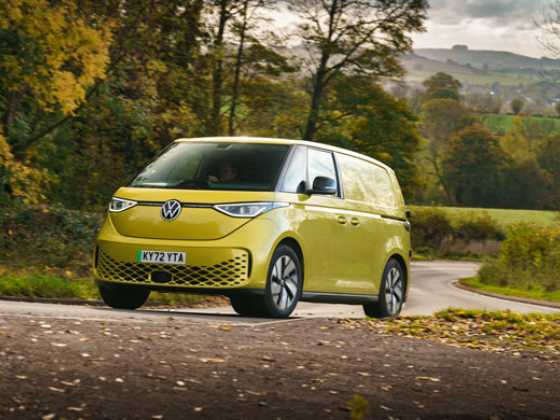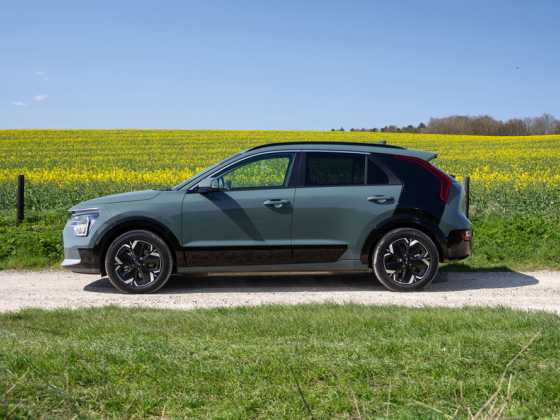In-fluence-ing the EV market
Renault’s EV Saloon arrives from across the channel to be met by the our herculean jolly green giant test driver, Roland Rendell
 As Renault embarks on a bold foray into battery-powered transport, they hope the Fluence ZE, together with the Kangoo ZE, Twizy and Zoe ZE, will help establish the French manufacturer as the leaders in the EV sector. And following the successful launch of the Kangoo ZE van, this mid-size saloon sees them off to a good start.
As Renault embarks on a bold foray into battery-powered transport, they hope the Fluence ZE, together with the Kangoo ZE, Twizy and Zoe ZE, will help establish the French manufacturer as the leaders in the EV sector. And following the successful launch of the Kangoo ZE van, this mid-size saloon sees them off to a good start.
The non-electric Fluence saloon available elsewhere in Europe measures 4618mm in length, which meant it’s electric brother needed stretching by 130mm to make way for the 280kg of lithium-ion batteries located behind the rear seats. It’s got a nice look to it from the side – kind of old-style Saab-ish, which isn’t a bad thing.
The relatively flat rear window does hold water when it’s raining, and I looked to see if a rear wash-wipe had been added. No such luck.
The car rides on low-rolling resistance Goodyear tyres and aero-efficient wheels. As well as the subtly reworked rear end, there are recharging points on both of the front wings - a good addition. Some of the cosmetic tweaks include a new rear light cluster, a blue tint to the lights, fog light surrounds and badging, plus chrome highlighting on the boot lid.
Having not experienced the combustion engine version, I can’t comment on whether there has been a compromise on the cabin space to accommodate the battery technology, but there’s plenty of room for someone of my bulk and no problems with legroom front and rear. Despite the vertical stacking of the battery pack behind the rear seats, the size of the boot remains the same as the conventional Fluence’s at 317 litres, although the shape is made awkward by the battery.
Keep out of the red
Turning the key illuminates a green ‘go’ on the dashboard, which also indicates the level of charge in the battery, and an ‘econometer’ which tells the driver how energy is being used. This is divided into three colour indicators: light blue shows the vehicle is running normally; dark blue denotes optimum performance; and red signals that the way energy is being used will have an impact on the driving range.
I engage ‘Drive’ and move away almost silently, with only a faint turbine-like whine. The power delivery is seamless and gets you from a standstill to 30mph in 4.1seconds. Acceleration from a standing start through the mid-range is crisp, as the 70kW (95hp) electric motor’s maximum 226Nm of torque are delivered instantly. The reducer, which operates in place of a gearbox, gives smooth, seamless driving.
One of the key things to remember when driving any EV is that the torque is immediately at your disposal, and although not of supercar proportions, the acceleration is sometimes a surprise. Heading away from the high road, I take on my first serious hill. The torque helps you glide effortlessly over the peak before the descent and deceleration kicks in. And this can also be somewhat of a surprise in that the technology is designed to recover the kinetic energy, and in doing so, slows the vehicle quite dramatically. Some say this is too harsh, whereas I find it a great feature, and quite fascinating that if you are not going too fast, this alone will bring you to a standstill, without applying the brakes.
The featherlight power steering is a delight. I mix it up in terms of driving style, stamping on the accelerator and watching the econometer’s needle leap into the red; lift off during a downhill descent and it falls into the blue as the kinetic energy recovery system replenishes the battery.
Eco Mode
Features to increase efficiency include an Eco Mode that restricts the climate control and heating functions as well as a pre-heating and pre-air conditioning system, which can be remotely programmed while the car is still on charge. A full recharge takes between six and eight hours, so Renault recommends the use of a home or work charging point as the main power source.
Renault can provide an optional EVSE battery charging cable, which can be used with a normal 240V domestic supply with power at 2kW. This way, the vehicle can be charged for a range of up to 25 miles in three hours. A standard daily battery charge takes between six and eight hours, when using the recommended Wall-Box charge point. The thing is, what do you wake up to in terms of range?
The claimed 115 mile range can vary from 50 to 125 miles, depending on how the car is driven. But be warned – if you drive aggressively and dip into the red too much, it can play havoc with your range.
The question I am always asked is Do I believe they have a real role to play in the fleet sector? And, in response, overall, they most certainly do. If your daily drive is a relatively short urban commute, without any real motorway or dual carriageway driving, the Fluence ZE should certainly be considered – particularly due to the benefits of no road tax, zero-rated benefit in kind and lower insurance and maintenance costs.
Where this, and indeed the other EV’s in the Renault line-up do stack up is cost. If you didn’t know already, the monthly cost of any Renault EV is for the vehicle only, and you can own the vehicle outright. The battery, you rent separately, and is owned by Renault. The Expression trim comes in at £21,845, coming down to £16,845 after the Government grant. The higher-spec Dynamique will set you back £900 more, with an OTR price of £17,745.
Battery cost varies depending on annual mileage. So for 3 years, if you do no more than 6,000 miles, you are looking at £76 per month, inc. VAT. Over the duration, it works out at £2,736. If you are looking at over 18,000 miles per annum, this will raise the cost to £133 per month inc. VAT, and again this means £4,788 over the duration of the agreement. This includes assistance with all breakdowns.
All in all, with the ZOE arriving soon, Renault has got off to a fast start to its EV journey. The Fluence is a great way to start the introduction of ‘proper-sized’ EVs into fleets. It’s nice to drive, is easy on the eye and once you get used to an EV driving style, you’ll reap the rewards financially. Said in my best possible French accent - C’est vanqueur!









